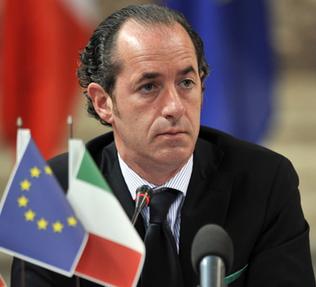
“The Italian Government sustains all the initiatives that help value and promote the Made in Italy and is committed to fighting counterfeiting and the phenomenon of ‘Italian sounding’, that creates so many damages to the Italian economy and agriculture. For these reasons we have come in the United States. In fact we want to sensitize the American consumers to the taste and the quality of the true products of our agriculture”.
These, the words of the Italian Minister of agricultural food and forestry policies Luca Zaia, who began his official visit in the United States October 20, 2009. The Italian delegation will be engaged for several days, in numerous institutional meetings and will be attending several promotional events of the agrifood Made in Italy.
“I have great expectations about this visit”, Zaia declared. “The USA – the Minister continued – are a great federal Country that has managed to build its identity on the cohabitation and the relationship between 50 States, a wonderful lesson for our society”.
Imitation apparel claiming “Made in Italy” have concerned and worried Italian companies and the government for quite some time. But the focus has broadened to include the food industry, including olive oil, salumi, cheeses, and even wine among other food goods. Estimates are that three out of four “Italian” food products sold abroad are counterfeit, and are doing enormous damage to Italy’s reputation and economy, with other countries producing and claiming a “Made in Italy” product.
Unfortunately, some of the fraud has taken place inside of Italy, where Italian inspectors and detectives have cracked down. Authorities in late 2007 seized some 1,000 hams in warehouses and supermarkets throughout Italy because the meat was branded with fake Parma prosciutto trademarks. No ham made outside the Parma area can bear the label Parma ham. The European Union’s highest court has upheld the bloc’s principle of protected food names, also ruling that only “Parmigiano Reggiano” — from Parma — can be sold as “Parmesan.” Many Italian products are already protected by existing EU regulations that lay down strict rules on the item`s origin and the manufacturing process, and ensuring consistent penalties for those who violate existing regulations.
The regulations that govern wine production in Italy can be strict and might seem complex, but when understood are simple. They may limit the percentages of grapes, what types of grapes are allowed into a certain type of wine, or simply a geographic area. A simple example is a wine that would be a Chianti that was grown outside the Chianti region, could not legally be labeled Chianti.
The Minister for Agricultural Policies Luca Zaia has praised the recent achievements being made: “Those who intend to deceive consumers has to face the zero tolerance phase-two, which we started to give a strong signal to those seeking to enrich themselves with tricks we are not to allow any longer. Honest consumers and producers can rest easy, because the controls in defense of our local products are becoming more effective.”
Today, the world can become more assured that the aggressive goals of Minister Luca Zaia and the Italian government, is to ensure the high quality reputation and authenticity of Made in Italy products and the regions they come from. Now is the time on a global level for the consumer to become more educated in their purchases — knowing that they are supporting the true Italian trade, farmers, vintners, designers, and artisans that have built the reputation of elegant design, exquisite quality, and unmatched excellence in authentic Made in Italy products.
For more information on Made in Italy products & services visit: